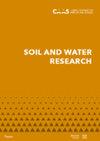白合花和苦楝籽壳活性炭吸附剂对水中重金属的有效去除
IF 1.7
4区 农林科学
Q4 SOIL SCIENCE
引用次数: 42
摘要
考虑到铅(Pb)和镉(Cd)等有毒金属的有害影响,清除它们刻不容缓。本研究将小檗和苦楝种子转化为活性炭吸附剂,用于吸附去除水中的铅和镉金属。用傅里叶红外光谱(FTIR)和扫描电镜(SEM)对所制备的吸附剂进行了表征。这两种金属的去除效率与它们的初始浓度、接触时间、pH、温度和吸附剂的数量密切相关。在pH为5,温度为20°C的条件下,在120分钟内,0.2 g两种吸附剂分别从100 ml 40 mg/l的浓缩溶液中去除75和62%的Pb和77和66%的Cd。Freundlich等温线和Langmuir等温线都很好地符合实验数据。我们相信这项工作将为合成低成本的活性炭吸附剂提供一种方便的方法,用于废水中高毒性金属的修复,为子孙后代保护我们的环境。本文章由计算机程序翻译,如有差异,请以英文原文为准。
The effective removal of heavy metals from water by activated carbon adsorbents of Albizia lebbeck and Melia azedarach seed shells
The removal of toxic metals like lead (Pb) and cadmium (Cd) is very urgent keeping their hazardous effects in view. In this work, seeds of Albizia lebbeck and Melia azedarach trees were converted into activated carbon adsorbents and applied for the adsorptive removal of Pb and Cd metals from an aqueous solution. The as prepared adsorbents were characterised by Fourier transform infrared spectroscopy (FTIR) and scanning electron microscopy (SEM). The removal efficiencies of both metals were strongly dependent on their initial concentration, contact time, pH, temperature and the quantity of adsorbents. 0.2 g of both adsorbents removed respectively 75 and 62% Pb and 77 and 66% Cd from from 100 ml of a 40 mg/l concentrated solution in 120 min at pH 5 and a temperature of 20°C. Both the Freundlich and Langmuir isotherms were well fitted to the experimental data. We believe that this work will provide a convenient way to synthesise low cost activated carbon adsorbents for the remediation of highly toxic metals from wastewater to safeguard our environment for future generations.
求助全文
通过发布文献求助,成功后即可免费获取论文全文。
去求助
来源期刊

Soil and Water Research
Water resources, Soil Science, Agriculture-WATER RESOURCES
CiteScore
4.60
自引率
0.00%
发文量
26
审稿时长
>12 weeks
期刊介绍:
An international peer-reviewed journal published under the auspices of the Czech Academy of Agricultural Sciences and financed by the Ministry of Agriculture of the Czech Republic. Published since 2006.
Thematic: original papers, short communications and critical reviews from all fields of science and engineering related to soil and water and their interactions in natural and man-modified landscapes, with a particular focus on agricultural land use. The fields encompassed include, but are not limited to, the basic and applied soil science, soil hydrology, irrigation and drainage of lands, hydrology, management and revitalisation of small water streams and small water reservoirs, including fishponds, soil erosion research and control, drought and flood control, wetland restoration and protection, surface and ground water protection in therms of their quantity and quality.
 求助内容:
求助内容: 应助结果提醒方式:
应助结果提醒方式:


